When the War of 1812 ended the U.S. Navy’s squadron, and the British vessels it had captured at the Battle of Plattsburgh Bay, were placed in ordinary at Whitehall, New York, the southern-most limit of navigation on Lake Champlain. In early 1815 the squadron consisted of five large warships: the former Royal Navy frigate Confiance, the ship Saratoga, the brig Eagle, the schooner Ticonderoga, and the former Royal Navy brig Linnet, five sloops, and ten gunboats. The sloops and four older gunboats were sold out of the service that year, five gunboats were sunk for preservation in the narrow lake channel just below Whitehall, and one gunboat, Allen, was kept in service for several years after the war. The five large warships were stripped of most of their equipment, their decks were housed over, and the empty hulls were anchored in a line alongside the main channel. By the year 1820 the vessels were riddled with rot and the navy moved them into the Poultney River, a tributary of the lake, about one mile north of Whitehall. Here they were allowed to sink to the bottom and finally sold to salvagers in 1825.
The fate of most of the naval vessels laid up and then abandoned at Whitehall can be traced through documents, maps, and archaeological remains. The 37-gun Confiance was the first of the five big ships to sink, no doubt the result of the frigate’s unusually hasty construction and poor materials (the commander of the Whitehall navy yard described the frigate’s scantlings as being “of the very worst timber for building ships”). Confiance was allowed to sink permanently in the Poultney River in 1820; four years later spring flooding washed the hull out of the river and into the main lake channel. The Navy Department ordered the hull moved and broken up, and dockyard records indicate that the hull was at least partially dismantled. The destruction must not have been complete, however, for a derelict hull marked “wreck of the Confiance” appears on an 1839 map of Whitehall prepared by the U.S. Corps of Topographical Engineers. Thirty-three years later, in 1873, a brief article in a Burlington, Vermont newspaper describes the destruction by explosives of a hull identified as Confiance. A Champlain Maritime Society (CMS) sonar survey of the Whitehall area in 1982 did not turn up any large wrecks in the vicinity of the Poultney River’s mouth, and a 1995 Lake Champlain Maritime Museum diver survey of the wreck site shown on the 1839 map revealed only a clean (and apparently recently-dredged) lake bottom. Thus, it is likely that Confiance, the largest warship ever built on Lake Champlain, no longer exists. However, the remains of Ticonderoga and the other vessels left in the Poultney River have been the focus of several archaeological examinations since the early 1980s.
Ticonderoga
In 1958 the town of Whitehall elected to recover a shipwreck from the Poultney River as part of the town’s bicentennial celebration. A hull was selected, and this salvage operation lacked archaeological precision and finesse. Bulldozers, saws and dynamite were used to dismantle and dislodge the wreck and was then trucked to downtown Whitehall and placed on display behind the Skenesboro Museum where it remains today. After its recovery the hull was measured and identified as the schooner Ticonderoga.
The salvaged hull of Ticonderoga was recorded as part of a CMS-sponsored project in 1981. Ticonderoga was laid down in 1814 as a steamboat for the Lake Champlain Steamboat Company, but was purchased by the U.S. Navy before completion and finished as a 17-gun schooner. The surviving structure showed evidence of the vessel’s steamboat origins and of modifications intended to improve its sailing characteristics.
Ticonderoga remains consist of an extensive assemblage of the vessels bottom structure. The entire keel is extant as well as the sternposts, stern deadwood, and frames extending out to the turn of the bilge. The surviving timbers demonstrate that the vessel would have had long narrow hull with a fairly flat bottom, typical of early steamships. In order to adapt the steamboat hull into a sailing warship a large amount of extra timber was added to the keel in order to increase the vessels depth and improve its sailing characteristics. Unfortunately, the upper portions of the vessel are entirely missing and it is therefore unclear what other modifications were made to the vessel to make it usable as a fighting craft.
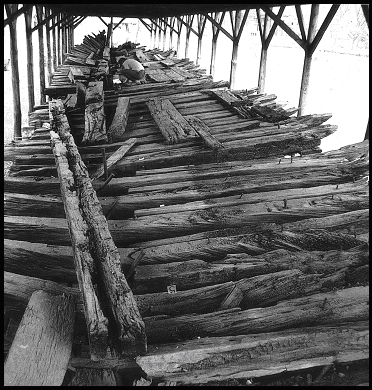
Photograph of the schooner Ticonderoga at the
Skenesboro Museum (LCMM Collection).
Eagle (Wreck Z4; NYSM 11636)
In 1981 a CMS-sponsored team of divers carried out a survey of the lower Poultney River to locate and assess other shipwrecks from the War of 1812 squadron. During this investigation three vessel hulls were located: the brig Linnet, a U.S. Navy row galley or gunboat, and the U.S. Navy brig Eagle. A two-year CMS project to record Eagle took place in 1982 and 1983, supported by funds provided from the Vermont Historical Society and by a federal archaeological survey grant provided through the Vermont Division for Historic Preservation.

Reconstruction of Eagle, with sail plan (by Kevin Crisman).
Of the vessels recorded in the Poultney River, Eagle was the most complete, due to the fact that it had fallen over onto its port side and was preserved up to the level of the gunports. Portions of the keel, keelson, lower stem and lower sternpost were found to be intact. The 106ft 5in (32.4m) keel is present on site as are a total of 44 frame assemblies that are mounted to the keel with iron bolts. On the port side the frames are intact above deck level where the top timbers frame 11 surviving gunports. The floors are sandwiched between the keel and keelson that contains evidence of the vessels two mast steps. In Eagle’s stern a portion of the lower sternpost is present as are four large pieces of deadwood that supported it. Hull planking and ceiling planking were also extensively preserved and documented.
Enough of Eagle’s remains were recorded to allow for a thorough reconstruction of the vessel to be carried out on paper. As this 20-gun vessel was built and launched in just nineteen days in the summer of 1814, and almost nothing was known of its design, dimensions and appearance from historical sources the data recorded during the project were vitally important in understanding the construction of American War vessels on Lake Champlain.
Allen (Wreck X4, NYSM 11635)
The U.S. Navy row galley wreck discovered near Eagle during the 1981 survey was one of six, 75ft (22.8m) long, gunboats built at Vergennes, Vermont in the spring of 1814. In 1815 the navy proposed to sell these six vessels, but they fetched such low bids that their sale was canceled and they were instead sunk for preservation in the lake. Only one, Allen, was kept in service as a patrol and survey vessel until 1825 when it was laid up in the mouth of the Poultney River with the other 1812 vessels.
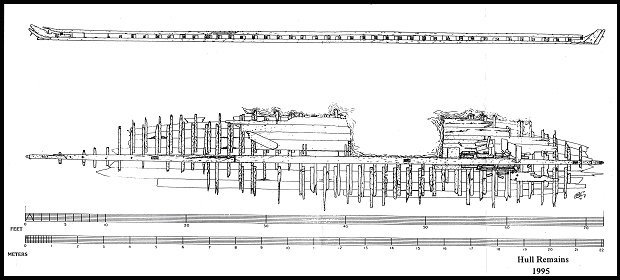
Plan view of the remains of Allen (by Eric Emery).
Allen underwent preliminary archaeological recording in 1982, including documentation of the lower stem and stern structure, keelson, and the eroded and broken ends of the port side. Full-scale investigation was not undertaken until a1995 archaeological field school run through the LCMM, University of Vermont and Texas A & M University and was sponsored in part by a federal grant administered by the Naval Historical Center. During the study the entire port side and most of the starboard side (which was preserved out to the turn of the bilge) were uncovered, a small but informative collection of artifacts was recovered, and the assembly details of the hull were extensively recorded.
Allen’s remains consisted predominately of the bottom structure of the vessel. Though it was difficult to examine, the keel is estimated to be nearly 70ft (21.3m) in length. A total of 45 floor timbers crossed the keel and were bolted to it with ¾in (1.9cm) iron bolts. The other frame timbers present on site are 63 first futtocks and 13 second futtocks.
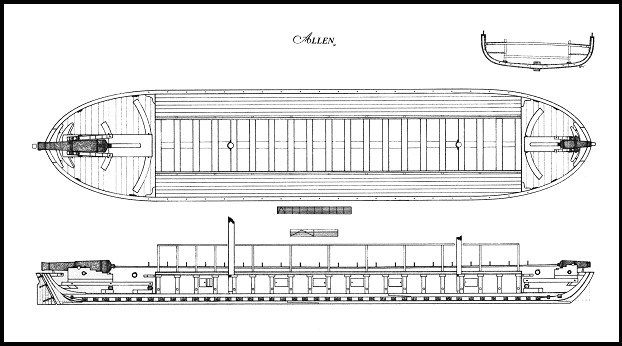
Reconstruction of Allen (by Eric Emery).
Portions of the stem, apron, sternpost, and stern deadwood are also extant on site. The majority of timbers in the vessel were crafted from white oak, though other wood types are found throughout the vessel. Several frames were found to be made from American beech, Red oak, and even American Ash, a notoriously poor shipbuilding timber. The presence of these inferior quality timbers, as well as the hasty craftsmanship displayed in many of the hull members, demonstrate the fact that this vessel was built rapidly and with a short life span in mind. That being said, the gunboat was built with sufficient strength and durability to carryout its assigned task with the minimum of construction time invested.
The artifact collection uncovered during the 1995 field season has revealed a considerable amount of information about life aboard the gunboat during and after its service in the War of 1812. A large number of fasteners were discovered, these were most likely from portions of the hull no longer present on site. A variety of ordinance was also recovered, most of which consists of various types and sizes of lead shot. Perhaps most revealing are the personal artifacts. This collection includes a “turk’s head” clay pipe, buttons, a bone domino, and a knife blade. Food preparation is evidenced by the presence of glass and ceramic fragments. Other vessel equipment includes a glass fragment that may be a portion of a deck light, and a large number of iron pigs that were used as ballast.
Linnet (Wreck Y4, VT-RU-26)
In October 1949 residents of the Whitehall area decided to raise a warship wreck in the Poultney River to recover and sell any artifacts that it might contain. A hull lying adjacent to the New York bank of the Poultney River was selected, steel cables were wrapped around the timbers, and three tractors and several horses managed to tug the hull free of the bottom and pull it partway onto the Vermont river bank. According to an eyewitness, the forward end of the hull broke off and drifted downriver, never to be seen again. The wreck was identified at the time as a “French-built” Revolutionary War-era “battleship,” but it was in fact the lower structure of the British-built 16-gun brig Linnet. The hull itself slipped back into the river after the salvage.
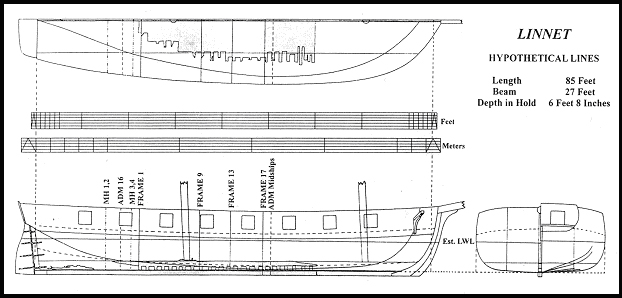
Reconstructed lines of Linnet (by Erika Washburn).
The remains of Linnet were rediscovered during a CMS-sponsored survey in 1981, and in 1982 the exposed timbers underwent preliminary recording. A more intensive study of the Linnet’s surviving 58ft (14.7m) length of hull structure was undertaken in 1995 as part of a nautical archaeology field school. During the month-long project the starboard side floor timbers and futtocks were uncovered and extensively recorded, a select number of the deeply-buried port-side frames were studied, and a small collection of artifacts was recovered and conserved at the LCMM Conservation Laboratory. Diver surveys of the New York side of the river in 1995 did not reveal any further remains of Linnet.
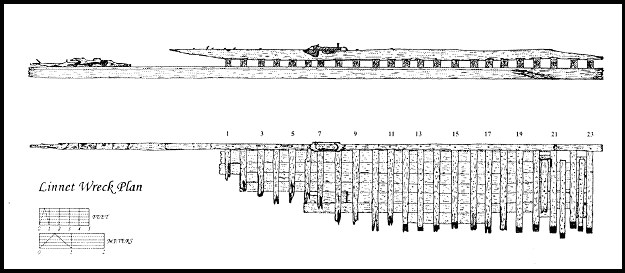
Site plan of Linnet (by Erika Washburn).
Linnet’s documentation revealed that the vessel had been carefully constructed using quality white oak timber. This is in stark contrast to Eagle and Allen that were built very quickly and often with timber of questionable value. Though there was not enough of the brig left for a detailed reconstruction, the data recorded in 1995 in conjunction with historic documentation has given archaeologists a much clearer picture of the British shipbuilding tradition on the freshwater lakes during the War of 1812. Unfortunately, the small artifact collection found during the 1995 project failed to reveal much about life aboard Linnet. The majority of items found on site were fasteners, though a small assortment of shot and a few buttons were also uncovered. It is clear that during the brig’s “recovery” in 1949 the majority of the artifacts were removed.
Information Sources:
Arthur Cohn ed., A Report on the Nautical Archaeology of Lake Champlain (Burlington, VT: Champlain Maritime Society, 1984), 73-75.
Kevin J. Crisman, The Eagle: An American Brig on Lake Champlain during the War of 1812. Published jointly by the New England Press, Shelburne, VT, and the Naval Institute Press, Annapolis, MD, 1987.
Kevin J. Crisman, The History and Construction of the United States Schooner Ticonderoga. Alexandria, VA: Eyrie Publication, 1983.
Eric Emery, “Whitehall Project 1995: A Preliminary Report on the Excavation and Study of the USN Row Galley Allen,” I.N.A. Quarterly 22 (1995), 9-14.
Eric Emery, “The Last of Mr. Brown’s Mosquito Fleet: A History and Archaeology of the American Row Galley Allen on Lake Champlain, 1814-1825” (Ph.D. dissertation, Texas A&M University, 2003), 235-255.
Erika Washburn, “The Story of HMS Linnet, a Brig from the War of 1812,” in Underwater Archaeology(1996).
